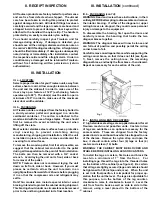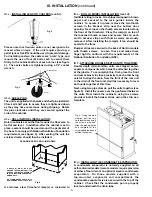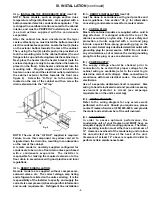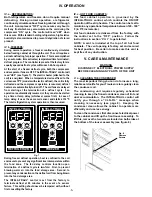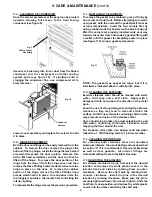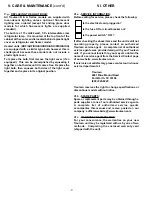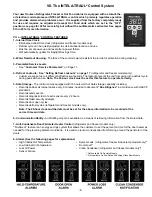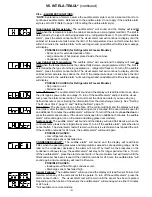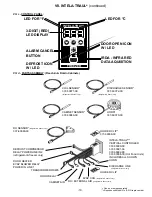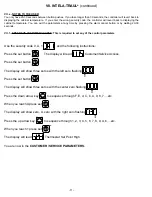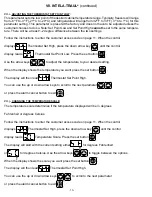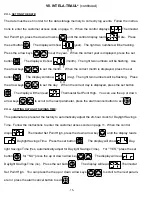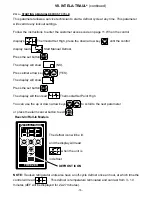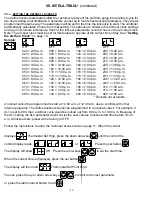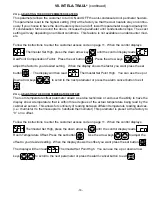
-3-
III. c - INSTALLING LEGS OR CASTERS (cont
’
d):
Please note that Traulsen units are not designed to be
moved while on legs. If the unit requires moving, a
pallet jack or forklift should be used to prevent damage.
For installing casters, the casters are
“
plate
”
type, and
require the use of four (4) bolts each to secure them
firmly to the cabinet bottom at each corner (see figure
3). The caster bolts are tightened using a 1/2” socket
wrench.
III. d - SHELF PINS:
The unit is supplied with shelves and shelf pins installed.
Check all shelf pins to assure they are tightened down
as they may have come loose during shipping. Rotate
the pins clockwise until they are secured against the
side of the cabinet.
III. e - ROLL-IN MODEL INSTALLATION:
Roll-In cabinets set on the floor require the floor area to
be flat and level. In addition, after the cabinet is set in
place, sealant should be used around the perimeter of
the base to comply with National Sanitation Foundation
requirements (see figure 4). After sealing the unit, the
enclosed ramp should then be installed.
A stainless steel threshold ramp(s) is included to
III. INSTALLATION
(continued)
Fig. 4
SEALING BASE OF ROLL-IN MODELS
A SEALANT MUST BE USED
AROUND THE PERIMETER OF THE
BASE OF CABINET AS SHOWN TO
FULLY COMPLY WITH SANITARY RE-
QUIREMENTS.
A RECOMMENDED SEALANT IS
DOW CORNING SILASTIC RTV #732
Fig. 3
Threaded Holes
Caster
Fig. 2
III. e - ROLL-IN MODEL INSTALLATION (cont
’
d):
facilitate rolling in racks. It is shipped wrapped in brown
paper and secured to the rack guides inside the
cabinet. To secure it in place, remove the two thumb
screws in the breaker strip near the bottom door
opening. Next, loosen the thumb screws located along
the floor at the threshold. Place the ramp(s) on top of
the loosened thumb screws and secure tabs on each
end to breaker strips with thumb screws previously
removed. After installing the ramp(s), it too should be
sealed to the floor.
Bumper strips are secured to the back of Roll-In models
with thumb screws. Loosen these and make them
finger tight to conform with the requirements of the
National Sanitation Foundation (NSF).
III. f - ATTACHING DOUBLE DEPTH UNITS TOGETHER:
Double depth roll-in/roll-thru units are shipped as two
separate components which must be attached together
at the jobsite. To accomplish this, first, place the front
and rear cabinets in close proximity to each other being
careful to align the drain from the front of the rear unit
to the drain of the front unit. It will be necessary to level
both units together at this time.
Next, using two pipe clamps, pull the units together (see
figure 5). Install the covers over the gap formed between
the units From inside the cabinets, using the screws
provided, install the breaker strips using the strip as a
template.
III. g - INSTALLING THE CONDENSATE EVAPORATOR:
A condensate evaporator is normally supplied on all
self-contained models (remote models require provision
of either a floor drain or an optional electric condensate
evaporator). On those models supplied with a
top-mounted evaporator coil compartment, the
condensate evaporator is also secured to the top of the
cabinet. Check that the condensate pan is properly
located underneath the drain tube.
Fig. 5 - Using two pipe
clamps, pull the two
units together and using
the screws provided.
Align the breaker strips
as a template for the
screw pattern inside and
outside the cabinet.



